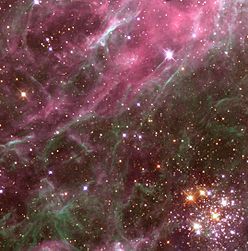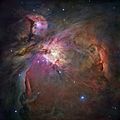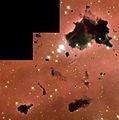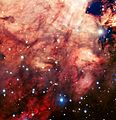H II region facts for kids
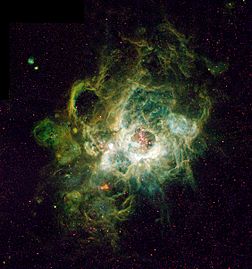
An H II region is a special place in space. It's where huge, bright blue stars are born. These regions are mostly made of hydrogen gas. They get their name, H II, because the hydrogen atoms in them are ionized. This means they have lost an electron.
Stars begin to form inside large clouds of hydrogen gas. The very big, blue stars that form in these regions don't live very long. But while they are alive, they give off a lot of ultraviolet light. This powerful light makes the surrounding gas become ionized.
Contents
What Are H II Regions Like?
H II regions can be incredibly big. They can stretch for hundreds of light-years across space. The first H II region we knew about was the Orion nebula. It was discovered way back in 1610.
These regions come in many different shapes. They often look lumpy or stringy. Sometimes they have very strange forms, like the famous Horsehead nebula.
How Stars Are Born and Grow Up
H II regions are like cosmic nurseries. Thousands of stars can be born there over millions of years. Eventually, all these new stars form a group called a star cluster.
But H II regions don't last forever. The most massive stars in them eventually explode as supernovae. They also create strong stellar winds. These powerful forces blow away the gas from the H II region. What's left behind is a beautiful cluster of stars, like the Pleiades.
Finding H II Regions in Space
We can see H II regions from very far away in the universe. Studying these regions in other galaxies helps scientists. It helps them figure out how far away those galaxies are. It also helps them learn what those galaxies are made of.
Spiral galaxies, like our own Milky Way, have many H II regions. So do irregular galaxies. But elliptical galaxies have almost none. In spiral galaxies, H II regions are usually found in the spiral arms. In irregular galaxies, they are spread out randomly.
Some galaxies have truly giant H II regions. These can contain tens of thousands of stars! Good examples are the 30 Doradus region in the Large Magellanic Cloud. Another is NGC 604 in the Triangulum galaxy.
Images for kids
-
Dark star-forming regions within the Eagle Nebula commonly referred to as the Pillars of Creation
-
Messier 17 is an H II region in the constellation Sagittarius.
-
Strings of red H II regions delineate the arms of the Whirlpool Galaxy.
-
An optical image (left) reveals clouds of gas and dust in the Orion Nebula; an infrared image (right) reveals new stars shining within.
-
Trifid Nebula seen at different wavelengths
See also
 In Spanish: Región H II para niños
In Spanish: Región H II para niños


